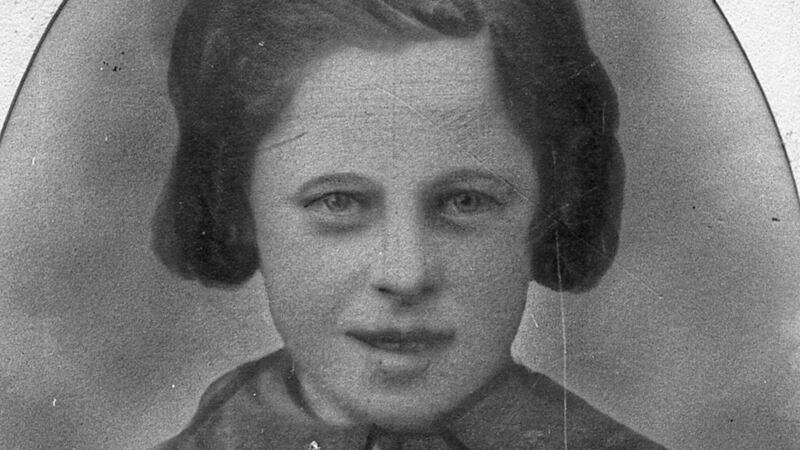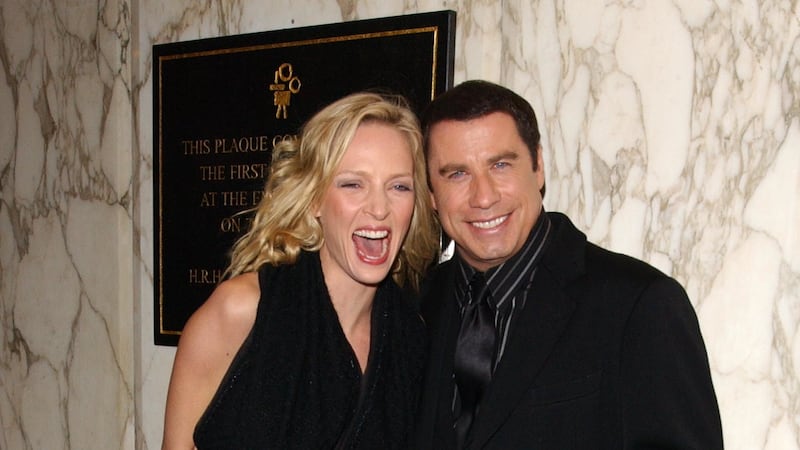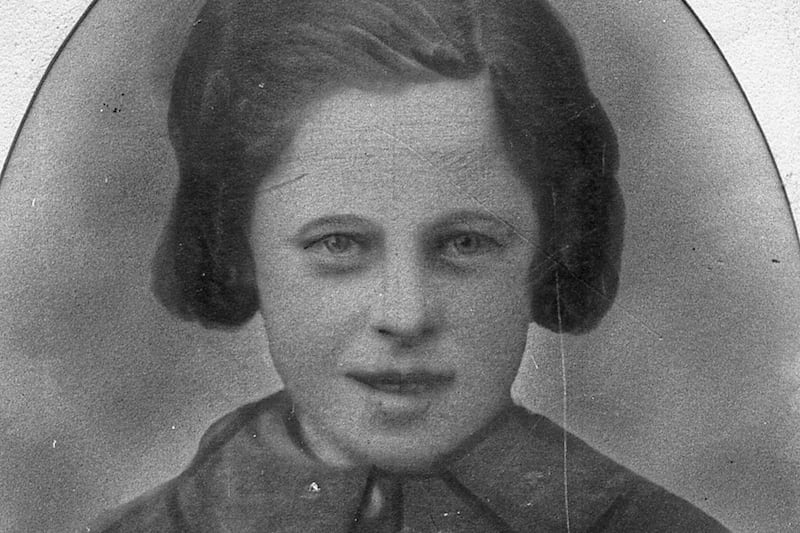PICTURED is Catherine 'Kitty' Kennedy; 100 years ago, on February 13 1922, Catherine, at 15 years of age, was one of the victims of an act of unimaginable savagery committed by loyalists against Catholic children playing on Weaver Street in north Belfast.
Weaver Street, off York Road, was a small Catholic enclave surrounded by Protestant areas. Although only 15, Catherine worked as a mill worker. At around 8.15pm on the night of February 13 1922, Catherine went to play with other girls on the street.
They skipped on a rope, tied to a lamppost. Just after 8.30pm, Catherine's brother, Patrick, noticed two suspicious looking men on the North Derby Street end of Weaver Street.
One of the men was seen crouching and throwing a bomb towards the middle of the group of girls playing with the skipping rope. The bomb was deliberately thrown to the spot where most of the children had gathered.
The bomb could be heard throughout the whole city. Shrapnel and chunks of metal flew everywhere. The bomb was followed by gunfire directed at the residents of Weaver Street, preventing parents from helping their children struck by the bomb.
Once the gunfire stopped, mothers and fathers ran to their children. The street was a scene of utter chaos with agonised screams puncturing the air. Mary Jane Kennedy was told that her daughter Catherine had been wounded and had been carried to 22 Weaver Street.
She was hit in the head and the body by shrapnel, covered in a pool of blood. She died shortly afterwards. Her brother Barney (13) was also injured.
Catherine and Ellen Johnstone (11) were killed almost instantly. Eliza O'Hanlon (12) died the next day and Rose-Anne McNeill (13) died from her injuries on February 22. Two women also subsequently died from their wounds - Maggie Smith (53) and Mary Owen (40).
Up to 20 others, mostly children, suffered horrific injuries - facial, head, torso, limb injuries - and were permanently scarred.
The Freeman's Journal described the heart-breaking scenes at the Mater Hospital: "When the wounded reached the hospital the entire staff was ready to receive them... Most of them had lost consciousness, but many were groaning and writhing in agony...
"Each child was carried into the hospital by the ambulance men, some of whom, hardened by contact with suffering, had been so moved by the scenes they had witnessed in Weaver Street, that they could ill repress the tears that welled into their eyes as they tenderly bore the groaning little ones into the building."
Responding to an outraged Michael Collins, British Colonial Secretary Winston Churchill described the bombing as "the worst thing that has happened in Ireland during the past three years".
A Jesuit priest, Patrick J. Gannon, claimed it was the worst atrocity since "Herod slew the innocents" in biblical times.
The Irish News stated the Weaver Street bombing "was the most appalling of the succession of crimes during the past eighteen months that have made the name of Belfast a bye-word in all parts of the civilised world".
Northern Ireland prime minister James Craig's condemnation was more qualified. While condemning the "dastardly deed, involving the lives of children2' in Weaver Street, "a Sinn Féin area", Craig was quick to point out that "the greatest tension has existed in Belfast since the kidnapping of Loyalists and the murderous attack on the police at Clones", claiming the "trouble began with firing on workers and Loyalists going to their work, the firing coming from a Sinn Féin locality".
Craig was referring to the kidnapping of over 40 loyalists in Tyrone and Fermanagh in early February by the IRA in response to the arrest of players from the Monaghan Gaelic football team in Tyrone and the planned execution of three prisoners in Derry jail; and the so-called 'Clones Affray' of February 11 where Ulster Specials on a train from Belfast to Enniskillen that had stopped-over in Free State territory in Clones in Co Monaghan were involved in a gun battle with the IRA which resulted in four Specials and one IRA member being killed.
The nationalist MP Joseph Devlin complained that by Craig referring to Weaver Street as "a Sinn Féin area", it was implied that it "was a Sinn Féiner who threw this bomb" at Protestant children.
Other nationalists condemned the unionist press silence on the potential involvement of the Ulster Special Constabulary in the bombing, with the Freeman's Journal claiming, "While a campaign of murder goes on, a campaign of misrepresentation accompanies it".
The residents of Weaver Street were adamant that the Specials were centrally involved in the bombing. At an inquest held at the beginning of March, just weeks after the bombing, they testified that two Specials had chased children onto Weaver Street from Milewater Street, one brandishing a revolver.
The Free State provisional government claimed that by shepherding more children onto Weaver Street, this "rendered the bombers' work more effective than if they had been scattered" over two streets.
More residents testified that three uniformed policemen were seen speaking to the two suspicious men moments before the bomb was thrown, hurriedly walking away once the conversation was over. Residents also produced spent bullets that had been fired into Weaver Street after the bomb went off.
The jury recommended that a special inquiry should be conducted, but this never happened. The victims received no justice. At claims courts they received a tiny margin of the compensation they sought.
George Johnstone received £50 for the death of his daughter, Ellen; her life apparently worth just £50.
The Catholic residents of Weaver Street had to endure more suffering shortly after the bomb, chased at gunpoint from their homes by loyalists in May 1922, displaced and homeless. The street that bore the name of this atrocity no longer exists either, the reminder of what happened on Weaver Street in 1922 no longer even visible on a street sign.
While there was much outrage immediately after the bombing, the condemnations soon faded, replaced by other atrocities that took place in Belfast in 1922.
Today, most people have never heard of the Weaver Street bomb. There is no memorial, no plaque, no mention in many history texts of the era. Given the nature of this vile crime, why has it been almost forgotten?
It could be forgotten because of the scale of the violence in Belfast in 1922, where, according to Kieran Glennon, author of From Pogrom to Civil War: Tom Glennon and the Belfast IRA, of the 498 killed violently in Belfast from the summer of 1920 to the summer of 1922, the peak of the violence was in the first half of 1922 when 270 people were killed, almost all civilian casualties.
Many children were killed. Historian Alan F. Parkinson estimates that just under 50 children were killed violently in Belfast during the sectarian violence in that period. Children had been specifically targeted by bombs before, including on Weaver Street when a bomb was thrown from a passing taxi. The Weaver Street atrocity became just one incident of savagery among many others.
Despite the scale of the political violence in Belfast from 1920 to 1922, very little is known of it south of the border. History in Ireland became partitioned when the island was.
Even in Belfast, knowledge and remembrance of the Weaver Street bomb is scant, with other atrocities such as the 'McMahon Murders', which happened over a month later, memorialised far more extensively.
On the 100th anniversary of the bomb, just over a week ago, there was little mention of it in media circles in the north. Even though Weaver Street no longer exists, there is no reason why a plaque cannot be erected close to the site of the atrocity.
Surely, it is the least we can do to remember Catherine 'Kitty' Kennedy and the other innocent children and women killed that day, and the many others scarred by this appalling crime, the most sickening and evil act committed in Belfast at the time.
::Cormac Moore is author of Birth of the Border: The Impact of Partition in Ireland (Merrion Press, 2019).



